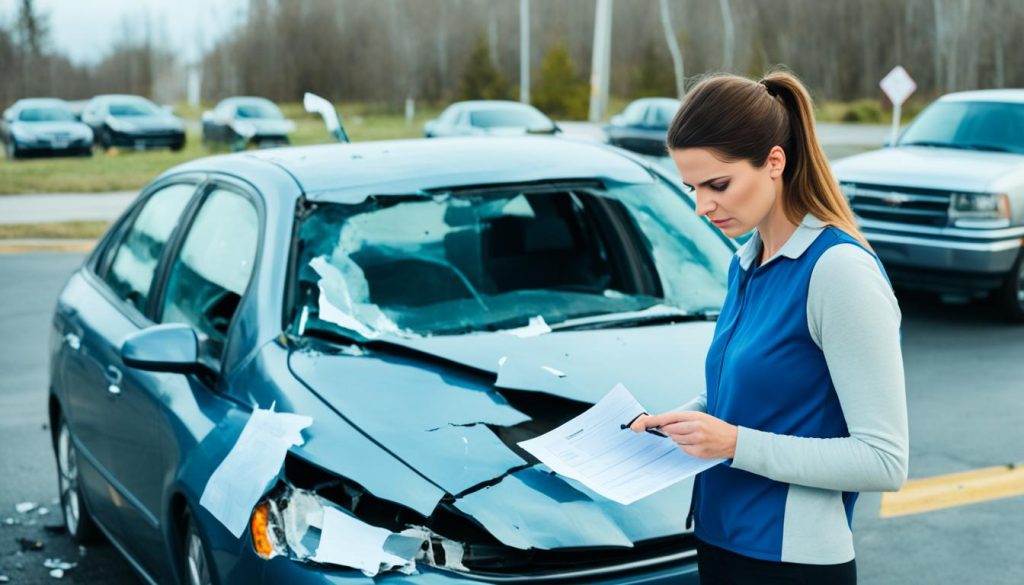Car damage can be a real hassle, whether it’s from an accident, a break-in, or a branch on your sunroof. Filing an insurance claim can make things even tougher. But, most insurance companies follow similar steps for claims1. Knowing what to do can ease the stress if you need to file a claim. It also helps ensure you get the full payout you deserve.
Key Takeaways
- The auto insurance claims process typically starts at the scene of the accident with steps to be taken immediately after the incident.
- Gathering critical information, such as the other driver’s details and witness contact information, is crucial at the accident scene.
- Contacting your insurance provider promptly after an accident is essential, as many allow online or app-based claims filing.
- Insurers may assist in providing a rental vehicle if your car is undrivable and you have rental car coverage.
- Communication with the insurance adjuster is vital as they determine the claim payout and available repair or replacement options.
- file auto insurance claim
- insurance claim tips
When to File an Auto Insurance Claim
You don’t have to file an auto insurance claim right after an accident. Your state’s laws might give you more time2. But, it’s best to start the claims process quickly. This can help you get your car back faster2. Filing a claim can also save you money. Your insurance might cover repairs, medical bills, and other costs up to your policy limits.
Scenarios Where Filing a Claim Is Recommended
Here are times when you should file an auto insurance claim:
- You caused an accident or damaged someone else’s car or property2.
- Another driver hit your car, even if it wasn’t your fault2.
- You got hurt in the accident. Filing quickly helps cover medical costs2.
- Fixing your car costs more than your deductible2.
Benefits of Filing a Car Insurance Claim
Filing a claim has many benefits:
- Your insurance might pay for repairs or a new car, up to your policy limits2.
- Liability coverage can protect you from paying for an accident you caused2.
- Comprehensive and collision coverage can cover damage from theft or natural disasters2.
- Your insurer can help with the claim process, like finding repair shops and solving disputes2.
But, remember, filing a claim can raise your insurance rates2. For small repairs, it might be cheaper to pay yourself if it’s less than your deductible2.
Knowing when to file an auto insurance claim helps you make smart choices. It protects your wallet and keeps your insurance costs down342.
“Filing a car accident claim may financially protect you in a number of ways, as your insurance company may help by paying up to your policy limits on any property damages or injuries you caused while driving.”
Gather Necessary Information at the Accident Scene
After a car accident, it’s key to collect important details at the scene. This can make the insurance claims process easier and boost your claim success chances5.
Details to Collect from the Other Driver
Make sure to get the other driver’s details. This includes their first and last name, address, driver’s license number, phone number, and insurance info. You should also note their vehicle’s make, model, year, and license plate5.
Documenting the Accident Scene
First, ensure everyone’s safety. Then, use your smartphone to take photos of the scene. Include the vehicle positions, damage, debris, road conditions, and any signs or signals5. If there are witnesses, get their names, phone numbers, and what they saw5.
If you’re too hurt to gather all the details, focus on getting medical help first5. After that, organize the info you have to support your insurance claim5. Getting legal help during this process can also be useful, with many firms offering free advice5.
| Information to Collect | Details |
|---|---|
| From the Other Driver |
|
| From the Accident Scene |
|

Collecting the right info at the accident scene is key for claims. By doing this, you can make the insurance claim process smoother and raise your chances of a successful claim5.
Contact Your Auto Insurance Provider
After an accident, it’s key to call your auto insurance company right away. You can reach out before leaving the scene, but make sure you’re safe first6. Many insurers offer online or app options for claims, but talking to a person can help you give all the needed details6.
Be ready to share the accident’s details like when, where, and what happened. You’ll also need to give info on the other driver, their car, and any damage or injuries6. Your insurer will help you with the claim process and tell you what they need6.
File your claim fast, usually within 30 days6. Waiting too long or missing info can lead to your claim being denied. So, be quick and give all the details asked for6.
The claims process changes based on your state’s laws and your policy7. Some states have no-fault laws, while others offer extra coverage like MedPay or underinsured motorist protection6. Your insurance person can explain what you need to do to file your claim7.
Quickly contacting your insurance and giving all the info helps with a smooth claim process. This way, you can get your car fixed and medical bills paid faster6. The main thing is to act fast, communicate well, and work with your insurance to get through the claims process6.
How to File an Auto Insurance Claim
First, make sure you’re safe and write down what happened in the accident. Then, call your insurance company to start the process of filing an auto insurance claim. They will give you a claims specialist or adjuster to work with you. This person will help you through the car insurance claim process, answer your questions, and help you get paid for damages up to your policy limits8.
Speaking with a Claims Specialist
Talk to the claims adjuster with all the details about the accident, like when and where it happened, and what happened. You’ll also need to give info about the other driver(s), like their contact and insurance details. The adjuster will use this to figure out who was at fault8.
If the other driver was at fault, the adjuster will talk to their insurance company for you. This makes the process of filing an auto insurance claim easier and helps you get the right compensation8.
Be ready to tell the adjuster about the damage to your car and any injuries you or your passengers had. They’ll use this to check your claim and figure out how much to pay you8.
The claims specialist will keep you updated on your claim and what you need to do next. They’ll also help with fixing or replacing your car and any rental car coverage you have8.
Always be honest and clear with the claims adjuster. Giving accurate info makes the process of filing an auto insurance claim go smoothly8.

Assessing the Damage and Repair Estimates
When you file an auto insurance claim, a claims specialist will check the damage to your vehicle. They’ll decide if your car is a total loss. Some insurance add-ons can change how this process goes9.
Understanding Total Loss Situations
If your car is new and you have new car replacement coverage, your insurer might pay for a new one if it’s totaled10. Gap insurance is also useful. It covers the gap between your car’s value and what you owe on your loan or lease9.
Insurance Add-Ons That Impact the Claims Process
There are more insurance options that can change how your claim is handled. For example, Geico might use their own adjusters for inspections and repair estimates9. You might also have roadside assistance and rental car coverage, which can help during the claims process10.
Knowing about these add-ons is key to understanding how your car’s damage will be assessed and your claims experience. Look at your policy to see what you’re covered for and what might affect your claim7.

The claims process can be fast, sometimes done in 48 hours with Geico9. But if your insurer takes too long, you can get your own repair estimates. Then, you can share them with your insurance company9.
Understanding the claims process and insurance add-ons helps you handle your car’s damage assessment better. This way, you can make sure you get the right coverage and support1097.
Follow Up and Troubleshoot Issues
Filing an auto insurance claim should be easy if you have a good insurance company and a skilled claims specialist. But, if you hit snags, knowing how to follow up and fix them is key11.
Your insurance company should help you out during the claims process, especially if you’re dealing with another insurer. If you hit a wall, reach out to your insurance company. See if they have a customer care rep or ombudsman who can help you11.
In states like Colorado, laws stop insurance companies from pushing you to certain repair shops11. People often choose repair shops that offer guarantees and clear repair times11. Most insurance companies list repair shops with repair and labor guarantees. This can make fixing your car smoother and quicker11.
Sometimes, the insurance might deny your claim or offer less money than you hoped. If this happens, speak up and ask them to look at your claim again. Give any extra proof or evidence you have, and keep talking to the insurance company12.
Each claim is looked at based on your specific situation, following your policy and the law12. If you can’t get things sorted with your insurance, you might need to file a complaint with your state’s insurance department or get legal help11.
Knowing your rights and being proactive with your auto insurance claim can boost your chances of a good outcome. It also reduces the stress and trouble of dealing with any issues that come up11.
Conclusion
Filing an auto insurance claim can seem tough, but knowing the steps and working with your insurance can make it easier. You’ll get your vehicle back on the road fast13. Stay calm, gather all needed info at the scene, and talk openly with your insurance company.
The time it takes to settle a claim varies a lot. It can be quick for simple cases or take months for complex ones13. Tell your insurance about the accident quickly, ideally within a day or two13. If the accident was your fault and caused injury, your premiums might go up. But, they won’t if it wasn’t your fault, it was your first, and you have a clean driving record13.
Knowing how the auto insurance claim process works helps you handle it better. You’ll make sure your car gets fixed and you get the right compensation1415. The main thing is to be proactive, keep records, and work with your insurance to fix the claim fast.
FAQ
When do I need to file an auto insurance claim?
You should file a car insurance claim if you’ve been in an accident, had your car broken into, or suffered other damage. This helps protect your finances by covering costs up to your policy limits.
What information should I collect at the accident scene?
Gather the other driver’s car and insurance info, witness contact details, and take damage photos if you can. But, don’t share your driver’s license with anyone to avoid identity theft.
How do I contact my insurance provider to file a claim?
You can usually file a claim online or through a mobile app. Or, call to talk to a live person to make sure you give all the right info. They’ll then assign a claims specialist to help you.
What happens during the claims process?
The claims specialist will check the damage to your car and decide if it’s a total loss. They’ll guide you, answer questions, and help you get paid for damages up to your policy limits.
How can I ensure a smooth claims process?
Stay calm, collect all needed info at the scene, and talk openly with your insurance company. If problems arise, ask for help from a customer care rep or ombudsman to fix them.
Source Links
- Filing a Car Insurance Claim: A Step-by-Step Guide | Bankrate
- What Is An Insurance Claim And When Should You File One? | Bankrate
- Filing a Claim with Another Driver’s Insurance Company
- When to File a Car Insurance Claim — and When Not To – NerdWallet
- What Information Should I Ask for After I’ve Been in an Accident? – The Beliz Law Firm
- How To File A Car Insurance Claim
- How to File an Auto Insurance Claim
- So You’ve Had an Accident, What’s Next?
- Getting a Vehicle Repair Estimate After a Car Accident
- Here’s how to file an auto insurance claim so you can get back on the road faster
- How to File an Auto Insurance Claim
- How to File a Car Insurance Claim – Nationwide
- What to Expect When You File an Insurance Claim | Mercury Insurance
- 3 Key Steps in Settlement of an Auto Insurance Claim | Inspektlabs
- Car Accident Claim Tips – A Practical Guide To Auto Claims – United Policyholders

